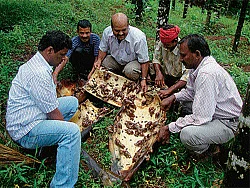

The giant African land snail is native to humid, forest areas but can also be found in agricultural areas, coast land, natural forest, planted forests, shrub lands, urban areas, and wetlands. The giant African land snail is seen to be highly invasive species and large colonies of land snails can be formed from just one individual.
Speaking to Deccan Herald, Zonal Agriculture Research Station Brahmavara Associate Professor Dr S U Patil said that the plantation crops that are being attacked by the pest in Shirthadi include arecanut, banana, cocoa and all kinds of vegetables that are grown in the area. “We have received complaints from two farmers that the snails have attacked forest plants like ‘Madhubhani’. However, we are yet to confirm it by testing,” he added.
Life cycle
The snail lives for five to six years if the environmental conditions are favorable. The shell is distinctive as it is relatively long, narrow and conical in shape. Although it may reach a length of 20 cms, the most commonly seen snails with a shell is 5 to 10 cm long. The shell is usually light brown in color, with darker brown and cream banding. The activity, growth and reproduction of the snail are highest in rainy weather, and the activities stop or slow down considerably during dry season.
The snail is nocturnal. It searches for food at night and hides away before sunrise. Adult snails can travel up to 50 meters in a single night. When conditions are unfavorable, the snail aestivates. It burrows into the ground or crawls under shelter, seals off the opening of the shell with a calcified membrane and waits, up to several years, for environmental conditions to improve.
Reproduction
The giant African snail is a hermaphrodite. Each individual has both male and female sex organs, but reproduction requires cross fertilisation. Young snails become sexually mature after 3 to 5 months. The shell is about 55 mm long when the snails mate, and 60 mm when they lay eggs. Egg laying begins 8 to 20 days after mating and then occurs at about monthly intervals during active periods. The eggs, which are yellow or cream in color and 4.5 to 5.5 mm in diameter, are laid just beneath the soil surface in batches of up to 400. The eggs hatch in 3 to 15 days. The number of eggs laid increases with the age of the snail and may reach 1,200 eggs per snail in one year.
Snail invasions start with a ‘population explosion’ when densities may reach several hundred snails per square meter.
Act on time
Patil said once the snail becomes established, it is very difficult to eradicate. If the snail is observed in an area previously free of the pest, it is essential to act quickly to control it. It is appropriate to activate an emergency response plan, he added.
The snail rarely moves on to bare ground. Consequently, a strip of bare earth about 1.5 m wide around cultivated areas will give some protection. In the same way, spreading bands of sand around cultivated areas will also prevent the snail from moving. Physical control measures are more effective if combined with chemical control and the regular collection of snails. Regular collection of snails from fields and gardens, particularly during rainy weather is a must.
The giant African snail can be baited with metaldehyde. If conditions are wet, the snail may recover from sub-lethal doses of metaldehyde. The higher concentration formulations give better control. The pellets should be spread evenly on the ground around crops in doses of 2.0 to 20 grams per square meter, depending on the metaldehyde concentration of the product. Scattering on non crop areas is not very effective. Baits should be checked every few days and renewed as necessary. Good field sanitation, the removal of mulches and other organic matter, will provide some control by reducing the number of breeding sites.
Pigs and poultry, with the exception of ducks, will hardly ever eat living giant African snails, but will eat them cooked. Under no circumstances should snails that have been poisoned with metaldehyde be used to feed pigs or poultry.
The giant African snail is so difficult to eradicate once it establishes. Effective quarantine to prevent its spread in the region is extremely important.
